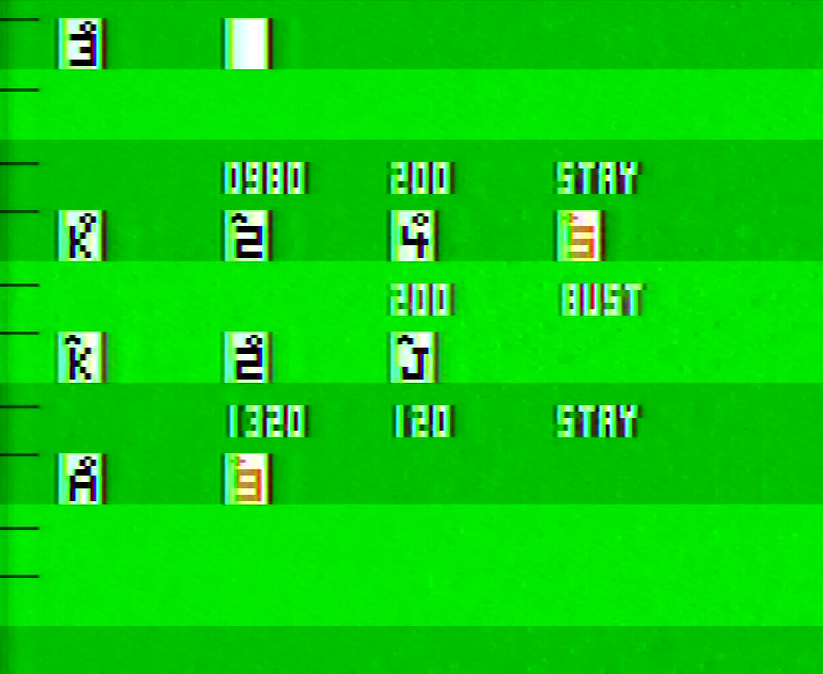
When the VCS launched around August 1977, one of its initial nine releases was Bob Whitehead’s Blackjack. This was a straightforward take on the classic card game that used the paddle controllers, allowing for up to three players to take on a computerized dealer with the goal of coming closest to a sum of 21 without going over. Whitehead explained that the programmers liked to joke about the target demographic being teenagers between the ages of 18 and 35 (which accounted for all of them), and Blackjack was one such game that he felt he’d be interested in playing. He wasn’t the only person who thought so, as RCA and Fairchild published their own Blackjack cartridges for the Channel F and Studio II, and in the years to come card games would appear on several other platforms as they launched as well. Gambling games were seen as something that game companies could sell to adults, and so seemingly everybody had at least one game of chance for sale on their game system. Whitehead had bigger ideas than just Blackjack, though. Halfway through development Whitehead decided he wanted to try and expand it to include other card games, but due to a need to pump out product ended up shelving the idea. He would ultimately get the opportunity to revisit the idea and create an expanded card game collection simply called Casino, or Poker Plus under the Sears label.
And poker is certainly the big difference between the two carts. Casino includes stud poker, poker solitaire, and two different rulesets for blackjack. The blackjack on Casino differs slightly from that of the original, standalone release in the ruleset options and in terms of player numbers. The 1977 Blackjack allows for three players, with the right difficulty switch tweaking victory conditions to change how ties are treated, if the player wins with four successful hits without going over 21, whether you can double your bet after getting your first two cards and drawing only one more, and when the dealer hits or stays on 17 or 18. The left switch adjusts whether or not the deck is reshuffled after 34 cards are used or after every hand. Casino carries over the reshuffling difficulty switch option in its entirety but otherwise has a series of changes to the game.
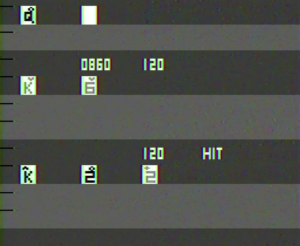
For starters, the right switch no longer controls whether or not you can double your bet after receiving your first two cards – the game just assumes you always want that as an option in the rules. The switch does still control whether or not the player wins after successfully hitting three times without going over and when the dealer stays, but that’s it. The game itself adds a new mechanic: insurance. If the dealer has one face down card and an ace, the game will allow you to make an insurance bet equal to half your original wager. If the dealer has a blackjack, you get double the insurance bet – so basically the same amount you bet originally. If not, you lose the insurance bet money and play continues on normally. It’s a neat wrinkle to the game, albeit not one that comes up often. Casino also brings in the possibility of splitting your hand; in game 1, if your first hand has two identical cards you have the option to split them into two hands with your original bet duplicated. You then play both hands normally, winning or losing with each one. Since this takes up a bunch of screen real estate, game 1 is only for up to two players; game 2 doesn’t include the splitting rule and allows for four players at once.
That’s blackjack, but as the Sears title notes poker is the big draw here, so to speak. The game’s stud poker rules allow for up to four players, and see the players betting or folding after each card is dealt until you’ve reached five cards, at which point you’re ranked based on your hand. Get a higher value hand than the dealer and you win the bet. The difficulty switches adjust whether or not the card is face up or down for the dealer or players, respectively.
The final game type is poker solitaire, where you have 25 cards to build the best poker hands you can. Simply spinning the knob on the controller will shift a cursor around the screen, and when you’re in the position you’d like, you can place the card at hand there. Once all 25 are placed you’re scored on each hand based on how strong they are.

I have no real experience with poker and am probably not the best person to be writing about how well this game handles it, but from a playability standpoint this version seems fine. Even if you don’t have a good sense for winning hands the game plays pretty quickly, and the paddle controls are quite intuitive. Like with Blackjack, Whitehead was proud of being able to get the VCS to reuse player sprites to create a series of high resolution cards, and the paddle controllers work well for the game. He said the logic of the poker game was pretty simple to implement, as were the rules, so really the challenge just came down to the display tricks. Casino also ended up being one of the early 4-kilobyte VCS games, of which we’ll see several more towards the end of 1979.
These card games naturally have a bit of a history with computer and video games. Blackjack was an early computer game, with Los Alamos engineers running it on an IBM-701 in 1954 to break down ways to play the game, and RCA engineers wrote a version of it called 21 for their prototype FRED computer. It was also the first game developed internally at Fairchild for the F8 microprocessor while it was still being developed, with an F8M dev system version programmed by Suresh Vasa and later used as the basis for the Channel F’s cartridge. Poker’s game history is a bit murkier, but conversions of it and blackjack appeared in David Ahl’s 101 Basic Computer Games and were ported around to various microcomputers of the 1970s and 80s. In the console space, the blackjack games for Channel F and Studio II had essentially come and gone by March 1979. Any new Studio II sales at this point were on clearance through Radio Shack, and Fairchild would rapidly bow out of the video game space within months of Casino’s release as the company disintegrated, but both were competent takes on the game – the Studio II Blackjack even had a colorized version included as a built-in game in the overseas Studio III clones. But Atari didn’t have a lock on the gambling game market; the VCS’s then-current competitors as of 1979 practically all had some kind of versions of blackjack and/or poker to offer up.
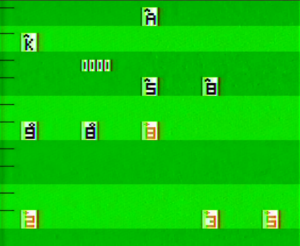
The Odyssey2 never got a poker game, but it did have Las Vegas Blackjack! at its 1978 launch. This particular game uses the system’s keyboard to input your bets and to decide whether or not you want to hit, stand, double down or get insurance, if the situation arises. Despite this, it’s actually not terribly intuitive the way the information is displayed, as all the prompts are in the same area, just color coded. It’s competent, but one of the lesser takes on the game. On the other hand you have APF’s MP1000 Blackjack game, which has well-rendered cards that you could even count if you were so inclined, defined areas of the screen for each player, and options to double or get insurance. This version uses the keypads on the controller, and has different maximum-bet options, as opposed to the Odyssey2 free-for-all.
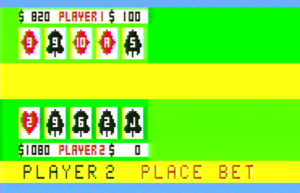
1978 also saw the release of Bally’s Blackjack, Poker and Acey-Deucey combination cart for its Professional Arcade. This particular take allows up to four players – like Atari’s – and uses the spinner knob on the controller to adjust your bets – also like Atari, but somewhat awkwardly, as depending on if the knob is in neutral or being pushed forward or pulled back, the game will adjust which column your bet is pulling from. This version does not allow for insurance in blackjack, but it does allow for splitting your hand if there are only two players. Poker here actually uses the five-card draw rules, with the tweak that the first five cards are all dealt face up. The drawing is done after the betting phase, with cards appearing in the center bar; the players choose whether or not they want to replace the card in the same column by pushing the controller’s trigger while that card is the one highlighted. It works, but it’s not a terribly elegant solution. It’s hard to compare this different poker ruleset to Atari’s, but it seems perfectly functional.
There are two more home carts of note that came out after Casino. The first is Mattel’s Las Vegas Poker and Blackjack for the Intellivision. This one is notable as being part of the initial four games sold in the November 1979 test markets that the consumer electronics company Sylvania reportedly held in Baltimore, Washington DC and Philadelphia and that Mattel absolutely conducted in the San Francisco Bay area; moreover, this was the pack-in title for the Intellivision.The game’s developer, David Rolfe, has indicated that its inclusion as a pack-in was to get around the Sanders Associate video game patent that covered any game where one moving object interacts with another moving object – something that doesn’t really happen here. Including a version of these card games with the Intellivision also sent a message, though. Home video games were largely considered a pursuit for children at this time, and while publishers included some games for teens and adults, it’s hard to escape kids as the main demographic being targeted – after all, people with more money could play more sophisticated coin-operated games, or possibly something on a computer. But children largely don’t care about blackjack or poker. Including this cartridge with the Intellivision makes it clear from the get-go that while kids can find games they enjoy on this system, there’s going to be plenty here for adults to enjoy, too.
This is a visually interesting take on the game that predominantly uses the Intellivision keypads to input bets, choose what move you’ll make, and even what game and ruleset you want to play. This cart includes several different version of poker, such as five-card stud, seven card stud, and five-card draw. There’s even an option for “dealer’s choice,” where the computer chooses randomly from the poker variants or blackjack. During the poker games players can push on the control disc to peak at their cards, though the manual suggests asking the other player to turn away at that time.
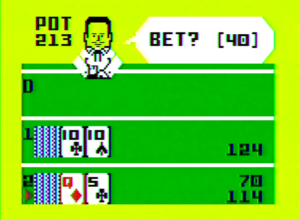
Rolfe included what he refers to as “fluff animation” with the shady-looking dealer flipping cards to players, glancing back and forth, and looking pleased when he wins a hand. Rolfe said that these animations, being scripted, weren’t too taxing to create. The game handily uses the Intellivision’s unique controller smartly: the keypad is used to help players select which card game they want to play (right down to what ruleset they want to follow), place their bets, and choose their moves. To do this, Las Vegas Poker and Blackjack comes with overlays that slide into the controller over the keypad. Many first-party Intellivision games include these, and while they’re not strictly necessary on a lot of games, they’re handy here. The 16-directional disc on the controller, which is ostensibly your joystick equivalent, is used here to peek at your cards in poker, though the manual suggests having the other players look away if you’re in a multiplayer match. For game modes, you’ve got blackjack and three variations of poker: five-card stud, seven card stud, and five card draw. You can also select “dealer’s choice,” and let the computer choose what game you play. Your pot of money will carry over between hands and games, adding a sense of continuity to gameplay. This is the gold-standard for early gambling video games, and due to being the pack-in title for the console well into 1982, some 1.9 million copies were shipped. That said, after Mattel changed the pack-in title to Astrosmash, they reportedly only shipped 2,500 copies during the first six months of 1983.
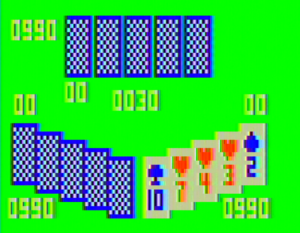
Also debuting post-Casino, we have Zircon’s Casino Royale, a draw poker game released most likely in the 1981 holiday season for the Channel F. This is also a draw poker game, and one that by necessity uses the Channel F’s controller. Players can thus awkwardly set their bets, draw cards, and decide whether to raise or fold by pushing and pulling the joystick. It’s not the best version of this game available, but it is fascinating that the console launched with Blackjack way back in the 1976 holiday season, while Casino Royale is very nearly the final new game to be sold on the platform five years later. Alongside Alien Invasion, this appears to be one of the only games not originally developed in-house at Fairchild before it sold its gaming division and rights to Zircon in 1979, and its authorship is presently unknown.

As for Casino? As I said earlier, the target demographic for these sorts of gambling games tended to be adults, and Casino was no exception – it featured prominently in Father’s Day advertisements in 1979. But this also means that coverage – largely directed towards teens – also tended to overlook it. The standalone Blackjack cart would be discontinued come 1982 – and even as early as fall 1979, Atari seemed to anxious to clear stock out with consumer promotions – but Casino continued to hang out on the market through 1989, albeit not in great numbers. Atari Corporation reported shipping a little more than 10,600 units from 1986 through 1989, making it one of the lesser sellers that the company was putting out during the VCS’s twilight years.
Still, if you want to get your video poker fix on the VCS, this is about the best you can ask for. And despite being essentially outclassed by Mattel’s game, Atari’s Casino is a perfectly competent take on these card games. At the least, you won’t lose your shirt.
Sources:
Bob Whitehead, interview with the author, Sept. 4, 2018
Cartridge Shipment Memo, Mattel Electronics dated Nov. 30, 1983
Atari Corp. 2600 Sales figures, 1986-1990
Atari History Timelines, Michael Current
Bob Whitehead, interview with Scott Stilphen, Ataricompendium.com, 2005
David Rolfe, interview with Scott Stilphen, Ataricompendium.com, 2004
Las Vegas Poker & Blackjack, blueskyrangers.com
Release date sources:
Casino, March 1979 – Source: New York Daily News, March 22 1979; Philadelphia Inquirer, April 8 1979;
Blackjack, November 1976 (Channel F) – Source: Weekly Television Digest, October 25 1976;Channel F launch brochure
Blackjack, September 1977 (Studio II) – Source: Weekly Television Digest June 6, 1977; Weekly Television Digest September 19, 1977
Blackjack, Fall 1978 (MP1000) – Source: Video Buyer’s Guide, Winter 1979, Fall/Winter 1978 Montgomery Wards catalog
Blackjack!, September 1978 (Odyssey2) – Source: Creative Computing, September/October 1978; Northwest Arkansas Times, November 22 1978; Colorado Springs Gazette, November 28 1978
Blackjack/Poker/Acey-Deucey, November 1978 (Bally Arcade) – Source: Baltimore Sun, November 5 1978
Las Vegas Poker & Blackjack, November 1979 (intellivision)– Source: Modesto Bee, December 10 1979; Mattel cartridge shipment memo, November 23 1983; Blue Sky Rangers game list
Casino Royale, Fall 1981 (Channel F) – Zircon sales brochure, Fall 1981
